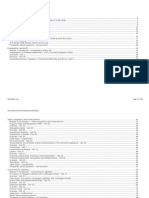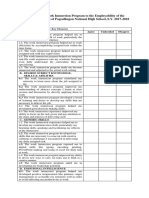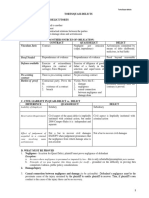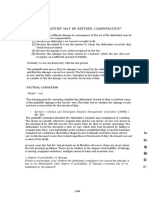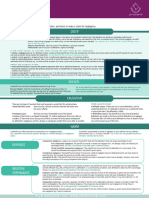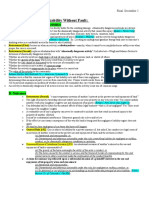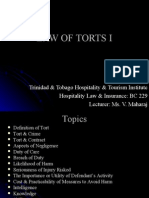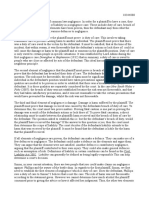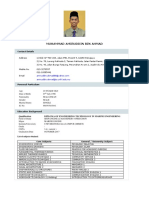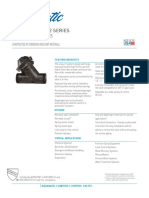Negligence - Causation and Remoteness of Damage - Topic Outline
Negligence - Causation and Remoteness of Damage - Topic Outline
Uploaded by
Josie BarracloughCopyright:
Available Formats
Negligence - Causation and Remoteness of Damage - Topic Outline
Negligence - Causation and Remoteness of Damage - Topic Outline
Uploaded by
Josie BarracloughOriginal Description:
Copyright
Available Formats
Share this document
Did you find this document useful?
Is this content inappropriate?
Copyright:
Available Formats
Negligence - Causation and Remoteness of Damage - Topic Outline
Negligence - Causation and Remoteness of Damage - Topic Outline
Uploaded by
Josie BarracloughCopyright:
Available Formats
Structure for Tort: Negligence – Causation in fact and law answering
a problem question on Structure for answering a problem question
Negligence – Causation in fact and Causation in law
THE BASICS
1. Make sure you have identified how the defendant has breached his duty of care (this becomes relevant
to establishing whether that breach is the factual and legal cause of the claimant’s harm)
2. Identify what harm the claimant alleges to have sustained as a result of the defendant’s breach of duty
FACTUAL CAUSATION
3. The ‘But for’ test:
a. The usual test is the ‘but for’ test
b. ‘But for’ the defendant’s breach of duty would the claimant have suffered the harm which he
complains about?
c. Better answers link to the specific breach of duty and the specific harm sustained
d. It is rarely necessary to depart from the ‘but for’ test
e. Avoid irrelevant discussions of alternatives to the ‘but for’ test (unless necessary)
f. The ‘but for’ test is usually met easily
4. There are some circumstances where the courts have developed principles allowing for departure from
the ‘but for’ test
a. There is a ‘scientific or evidentiary gap’ which means that the claimant is unable to satisfy the
usual ‘but for’ test and it is fair to apply a different test:
i. Material contribution to damage:
o the defendant’s breach of duty has materially contributed to the damage sustained by
the claimant (i.e. based on severity)
o the damage is more than minimal (‘de minimis’)
o the claimant cannot prove that the claimant would not have sustained the harm had
the defendant not breached the duty
o if this test is met, the defendant is liable to the extent that their contribution can be
attributed to the claimant’s damage (subject to any contributory negligence by the
claimant). Sometimes the contribution cannot be measured and the claimant
recovers damages in full.
ii. Material increase in the risk of harm:
o the defendant’s breach of duty has materially increased the risk of the claimant
sustaining by the claimant (i.e. based on likelihood of harm)
© Northumbria University 1 Tort
o the Tort: Negligence – Causation in fact and law increase in
Structure for answering a problem question
risk is more than
minimal (‘de minimis’)
o the claimant cannot prove that the claimant would not have sustained the harm had
the defendant not breached the duty
o if this test is met, the defendant is liable in full (subject to any contributory
negligence by the claimant)
iii. Multiple causes: ‘the Fairchild’ approach (‘indivisible injuries’ only)
o the claimant’s harm could have been caused by a breach of duty by one or more of
several defendants
o certain types of physical conditions only (typically mesothelioma)
o the claimant cannot prove that the claimant would not have sustained the harm had
the defendant not breached the duty
o ‘interests of justice’ justify departure from the ‘but for’ test
o if this test is met, the defendant is liable in full (subject to any contributory
negligence by the claimant)
iv. Apportionment (‘divisible injuries’ only)
o the claimant’s harm could have been caused by a breach of duty by one or more of
several defendants
o the severity of the claimant’s harm depends on the contributions made by different
causes
o the contributions made by different causes can be measured
o if this test is met, a defendant is liable to the extent that their contribution can be
attributed to the claimant’s damage (subject to any contributory negligence by the
claimant)
© Northumbria University 2 Tort
b. Contributory Tort: Negligence – Causation in fact and law negligence
i. Harm Structure for answering a problem question contributed
to by the defendant’s breach of duty and the claimant’s failure to take reasonable care for
himself.
ii. Law Reform (Contributory Negligence) Act 1945
iii. Court has discretion to reduce damages. See ‘Defences’
LEGAL CAUSATION / ‘REMOTENESS’
5. There are several inter-related principles:
a. Type or kind of harm: the defendant is not liable for a consequence of a type or kind which is
not reasonably foreseeable
i. Judged at the time of the defendant’s breach
ii. A broad approach to ‘type’ is usually taken – test is easier to meet
iii. Some cases have adopted a narrow approach – test is harder to meet
b. If the type or kind of harm which the claimant eventually sustains is reasonably foreseeable at
the time of the defendant’s breach, then:
i. The defendant must take the actual claimant as he finds him (the ‘thin skull’ or ‘eggshell
skull’ rule applies) - the defendant remains liable even if the extent of the claimant’s actual
harm is greater than that which was reasonably foreseeable – because of the claimant’s
pre-existing vulnerability;
ii. The extent of the harm is irrelevant - the defendant remains liable even if the extent of the
claimant’s actual harm is greater than that reasonably foreseeable – because of something
other than the claimant’s pre-existing vulnerability;
iii. The way in which the harm is caused is irrelevant - the defendant remains liable even if the
damage was caused in a way not reasonably foreseeable;
For each of the above, Identify the test, Define it (with authority), Explain how it applies (e.g. how that
factor operates on the topic of legal causation), and Apply to the facts (identifying any
differences/similarities with authorities)
© Northumbria University 3 Tort
INTERVENING ACTS Tort: Negligence – Causation in fact and law
Structure for answering a problem question
6. Intervening acts: the defendant is not liable for damage caused by an intervening act or highly
unreasonable conduct by a claimant
a. Intervening act by a third party (i.e. other than the defendant or claimant), such as medical
treatment, intentional wrongs, negligence
b. Highly unreasonable conduct by the claimant (e.g. taking unreasonable risks, rescuers (unlikely))
i. relationship with contributory negligence as an alternative
ii. relationship with failure to mitigate as an alternative
c. An act of nature
7. An intervening act:
a. must be beyond the scope of the duty owed by the defendant to the claimant
b. will break the chain of causation between the defendant’s breach of duty and the harm to the
claimant that results from that breach of duty
c. is an ‘all or nothing’ approach in relation to that harm – there is no apportionment
MULTIPLE ‘SUFFICIENT’ SUCCESSIVE CAUSES
8. Where a defendant breaches a duty to the claimant, and causes some harm to the claimant, but then a
later event also causes similar harm to the claimant, should the original defendant remain liable?
9. Before the later event
a. The test for factual causation is met against the original defendant
b. The original defendant will remain liable for harm caused up until the later event
10. After the later event – has the later event ‘obliterated’ the original defendant’s liability?
a. Later torts which would have caused the same eventual harm - the defendant
i. possibly remains liable to the claimant
ii. may be able to claim a contribution from a later defendant
b. Later events other than torts (e.g. natural causes) which would have caused the same eventual
harm - the defendant is no longer liable after the later event
NOW MOVE ON TO CONSIDER DEFENCES
© Northumbria University 4 Tort
You might also like
- Tort Final Pre WritesDocument5 pagesTort Final Pre WritesMartin Avanesian100% (1)
- Torts: QuickStudy Laminated Reference GuideFrom EverandTorts: QuickStudy Laminated Reference GuideRating: 5 out of 5 stars5/5 (1)
- Annotated Bible With MarginsDocument2,440 pagesAnnotated Bible With Marginscjvscribd100% (5)
- Exam Answer Outline-TortsDocument3 pagesExam Answer Outline-TortsAhmad A. Hussein100% (1)
- Torts Outline - SpringDocument26 pagesTorts Outline - Springspoonman2120No ratings yet
- Adv Legal Writing Hardware StoreDocument5 pagesAdv Legal Writing Hardware StoreAnonymous oAx0OaMSDNo ratings yet
- GNG 4170 NotesDocument25 pagesGNG 4170 NotesJoshua HarrisNo ratings yet
- Torts OutlineDocument57 pagesTorts Outlineang3lwings100% (1)
- The - Power - of - Retail Design A Step by Step Guide To Increased Profits Through Strategic Retail Design by MARK MULLER (PRADYTVADocument289 pagesThe - Power - of - Retail Design A Step by Step Guide To Increased Profits Through Strategic Retail Design by MARK MULLER (PRADYTVAAlex Ionut100% (2)
- Acca IfrsDocument109 pagesAcca Ifrsesam5278No ratings yet
- Builders 13052010 BangaluruDocument11 pagesBuilders 13052010 BangaluruManish Tiwari100% (2)
- The Effects of Work Immersion Program To The Employability of The Graduating Students of Pagsulhugon National High SchoolDocument10 pagesThe Effects of Work Immersion Program To The Employability of The Graduating Students of Pagsulhugon National High SchoolMaria Theresa Deluna Macairan75% (4)
- First Year Torts OutlineDocument16 pagesFirst Year Torts Outlinenicole_huddlest6741No ratings yet
- Law of Torts NotesDocument4 pagesLaw of Torts Noteslorriejason4No ratings yet
- The Element of Negligence DamagesDocument3 pagesThe Element of Negligence DamagesJoey YutangcoNo ratings yet
- Torts Memory Aid AteneoDocument11 pagesTorts Memory Aid AteneoStGabrielleNo ratings yet
- Civillaw (Torts) Memoryaid A B O 2002Document14 pagesCivillaw (Torts) Memoryaid A B O 2002Maricar Corina CanayaNo ratings yet
- Torts Quasi DelictsDocument10 pagesTorts Quasi DelictsAlex GraciaNo ratings yet
- Torts Quasi DelictsDocument10 pagesTorts Quasi DelictsSonnyNo ratings yet
- NegligenceDocument37 pagesNegligenceTDM SNo ratings yet
- Unit-Iv Causation and Tests of DamageDocument30 pagesUnit-Iv Causation and Tests of DamageDivyank DewanNo ratings yet
- Chapter 4 Law of TortDocument26 pagesChapter 4 Law of TortNur Farah AqilahNo ratings yet
- Week 4 - AnswersDocument10 pagesWeek 4 - AnswersCharvi jainNo ratings yet
- 10d - Negligence Flow (Main 5)Document1 page10d - Negligence Flow (Main 5)Beren RumbleNo ratings yet
- Asignemtn CrimDocument2 pagesAsignemtn Crimjackham7734No ratings yet
- Intentional Torts 2Document35 pagesIntentional Torts 2Nguyễn HiềnNo ratings yet
- Tort of NegligenceDocument8 pagesTort of NegligenceClitonTay100% (2)
- Law of NegligenceDocument16 pagesLaw of NegligenceSufyan SallehNo ratings yet
- Manchester Metropolitan University Business School Economics and Law Law Lecture Handout 9 TortDocument11 pagesManchester Metropolitan University Business School Economics and Law Law Lecture Handout 9 Tortazmat18100% (1)
- Fundermental of law - Alice Adams - Thầy KhánhDocument29 pagesFundermental of law - Alice Adams - Thầy Khánhhomyduyen310No ratings yet
- Negligence in Law of TortsDocument12 pagesNegligence in Law of Tortsagarwalassociate12No ratings yet
- Negligence in Law of TortsDocument12 pagesNegligence in Law of Tortsagarwalassociate12No ratings yet
- Torts I Outline: Chapter 1: An Overview of Modern Tort LiabilityDocument56 pagesTorts I Outline: Chapter 1: An Overview of Modern Tort LiabilityEric CampoloNo ratings yet
- Negligence, Strict and Absolute LiabiltyDocument19 pagesNegligence, Strict and Absolute LiabiltyNeeharika Maniar100% (1)
- Torts Master OutlineDocument59 pagesTorts Master OutlineSarah ReynoldsNo ratings yet
- TortsDocument2 pagesTortsskellyNo ratings yet
- Respondeat Superior Doctrine-The Doctrine Holding An Employer or Principle Liable ForDocument60 pagesRespondeat Superior Doctrine-The Doctrine Holding An Employer or Principle Liable Forelizabeth8903No ratings yet
- Tort Law Lectures BarbriDocument6 pagesTort Law Lectures BarbriKarthik Shetty100% (1)
- Torts OutlineDocument14 pagesTorts OutlineZachary ScottNo ratings yet
- NegligenceDocument8 pagesNegligenceptangoericsson100% (1)
- Idiot's Guide (Tort) (NBS AB1301)Document6 pagesIdiot's Guide (Tort) (NBS AB1301)Eddie PohNo ratings yet
- 11 NegligenceDocument11 pages11 Negligencenatsu lolNo ratings yet
- GoodnotesDocument18 pagesGoodnotesmhmmx6969No ratings yet
- Torts Rules of Law (Simplified)Document4 pagesTorts Rules of Law (Simplified)Baber RahimNo ratings yet
- Torts OutlineDocument67 pagesTorts OutlineBeeBeeTwo100% (2)
- Law AssignmentDocument6 pagesLaw AssignmentThe PulpitNo ratings yet
- Torts II OutlineDocument27 pagesTorts II OutlinechristineNo ratings yet
- Causation, Remoteness, Scope of Liability PRESENTATIONDocument6 pagesCausation, Remoteness, Scope of Liability PRESENTATIONVivian LeeNo ratings yet
- Remedies in TortDocument53 pagesRemedies in TortNUR DINIE SANI BINTI HASRUL SANINo ratings yet
- Law of Torts IDocument53 pagesLaw of Torts IVM100% (1)
- Unit 3 - Torts and Insurance LawDocument17 pagesUnit 3 - Torts and Insurance LawmmNo ratings yet
- Analyzing Nursing Malpractice Court Cases, Lexis-Nexis On-Line, Policy DevelopmentDocument13 pagesAnalyzing Nursing Malpractice Court Cases, Lexis-Nexis On-Line, Policy DevelopmentJudy RichardNo ratings yet
- Negligence AssignmentDocument2 pagesNegligence AssignmentIbbyNo ratings yet
- Contributory NegligenceDocument12 pagesContributory Negligencesai kiran gudisevaNo ratings yet
- Law of TortDocument6 pagesLaw of TortSenelwa AnayaNo ratings yet
- Qtys-328 Law of Tort 2019-2020Document18 pagesQtys-328 Law of Tort 2019-2020yusufaliy510No ratings yet
- Law of TortDocument27 pagesLaw of TortLydia AzmiNo ratings yet
- TOPIC 7 - The Law of TortsDocument8 pagesTOPIC 7 - The Law of Tortsusoroa1409No ratings yet
- Gale Researcher Guide for: Criminal Defenses and Their Role in Criminal ProceedingsFrom EverandGale Researcher Guide for: Criminal Defenses and Their Role in Criminal ProceedingsRating: 5 out of 5 stars5/5 (1)
- The Law of Torts: A Concise Treatise on the Civil Liability at Common Law and Under Modern Statutes for Actionable Wrongs to PersonFrom EverandThe Law of Torts: A Concise Treatise on the Civil Liability at Common Law and Under Modern Statutes for Actionable Wrongs to PersonNo ratings yet
- LLB 2ND SemDocument5 pagesLLB 2ND SemAarzoo GirdharNo ratings yet
- Working With FunctionsDocument11 pagesWorking With Functionsdalefav101No ratings yet
- 19 C New PO 56235256201449 DT 01-SEP-23 On VINDHYA TELELINKS LIMITED-REWADocument8 pages19 C New PO 56235256201449 DT 01-SEP-23 On VINDHYA TELELINKS LIMITED-REWAManojNo ratings yet
- Demo DWDocument85 pagesDemo DWnguyentranminhnhatkdNo ratings yet
- Industrial Report On Saras DairyDocument88 pagesIndustrial Report On Saras DairyDeepak ChelaniNo ratings yet
- Saran Offer LetterDocument3 pagesSaran Offer LetterVijay Prabu100% (1)
- 1.launch The Below URL's in Firefox BrowserDocument6 pages1.launch The Below URL's in Firefox BrowserRani raniNo ratings yet
- Cable Tray CertificateDocument1 pageCable Tray CertificatePritam MitraNo ratings yet
- The Road To Go-Live Handbook: Running A Data-Driven System MigrationDocument21 pagesThe Road To Go-Live Handbook: Running A Data-Driven System MigrationCarlosArturoQuirogaNo ratings yet
- PHA Contact Report WADocument8 pagesPHA Contact Report WAdarkchipmunk668No ratings yet
- Reading Line of TextDocument4 pagesReading Line of TextTheophilus ParateNo ratings yet
- ID Pola Pemakaian Kontrasepsi Dan PemanfaatDocument15 pagesID Pola Pemakaian Kontrasepsi Dan PemanfaatRosdianaNo ratings yet
- User'S Manual: Watt/Watt-hour TransducerDocument30 pagesUser'S Manual: Watt/Watt-hour TransducermihaiisvoranuNo ratings yet
- CBSE School ListDocument41 pagesCBSE School ListprabakaranNo ratings yet
- Muhammad Amiruddin Bin Ahmad: Contact DetailsDocument3 pagesMuhammad Amiruddin Bin Ahmad: Contact DetailsMuhammad Amiruddin Bin AhmadNo ratings yet
- Examcoe 1338Document33 pagesExamcoe 1338Onkar KhutwadNo ratings yet
- Q & A ExamDocument12 pagesQ & A ExamAkshay KumarNo ratings yet
- 1229846-EN - Aquamatic - K52-Valve - SpecSheet - Rev D MA2016Document4 pages1229846-EN - Aquamatic - K52-Valve - SpecSheet - Rev D MA2016Singgih KurniawanNo ratings yet
- Seville Classics v. Honey-Can-Do - ComplaintDocument45 pagesSeville Classics v. Honey-Can-Do - ComplaintSarah BursteinNo ratings yet
- Chapter 2: Lesson 1: Kinds of Qualitative Research, Strengths & WeaknessesDocument22 pagesChapter 2: Lesson 1: Kinds of Qualitative Research, Strengths & Weaknessesjulieanne_portalNo ratings yet
- Engineering EconomymcqDocument18 pagesEngineering EconomymcqSyrr Joson IbayanNo ratings yet
- Fabian Canales CheatDocument168 pagesFabian Canales CheatFabián MirandaNo ratings yet
- Srs Event Management System PDF FreeDocument4 pagesSrs Event Management System PDF FreeShubham YadavNo ratings yet
- Kenwood Stereo Reverberation Amplifier Ra-59Document8 pagesKenwood Stereo Reverberation Amplifier Ra-59lunwenNo ratings yet
- CH 05Document34 pagesCH 05Rajat SahooNo ratings yet










